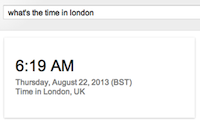Update: there is a new up-to-date version of this article published here: 10 tips to get your website to the top of Google.
Ten years ago, creating a website and getting found in Google wasn’t hard to do. Choose a domain. Learn some basic HTML code. Do some keyword research. Create some title tags and meta tags. Write about 250 words. And for the most part, you were done.
With Google’s more recent quest for quality, authenticity, authority, and usability, however, many of of the tips that could help get your site to the top of Google 10 years ago might not produce the same results today.
Here are 10 top tips on how to optimize your site for Google’s algorithm today and beyond.
1. Learn & Implement Marketing Basics
Start with a plan, not a prayer.
 No matter how many buzzwords, new paradigms, disruptive technologies, or innovative inventions are introduced, search engine optimization (SEO) at its most fundamental is marketing. Marketing on the web, with efforts, outcomes, metrics that matter and competition for marketing dollars.
No matter how many buzzwords, new paradigms, disruptive technologies, or innovative inventions are introduced, search engine optimization (SEO) at its most fundamental is marketing. Marketing on the web, with efforts, outcomes, metrics that matter and competition for marketing dollars.
It doesn’t matter if it’s SEO for a mom and pop store, or a national online retailer. Attacking SEO without a plan is like trying to row a boat with no oars – you might eventually get somewhere, but it won’t be where or when you wanted to arrive.
When I hired my first employee at my agency in 2002, the first thing I did was have them read the excellent “Marketing for Dummies” book, that lays out some basic principles. (they have a great marketing cheat sheet for reference)
Answer (at least) these questions:
- What is your expertise?
- What is your differentiation?
- Why should users care?
- Which users (age, locations, interests etc.) should care?
- What is the message and / or media that is going to connect with them?
- Who is your likely competition?
- Why should Google rank you higher than your competition?
Conduct research. Segment your audience. Set realistic goals for your SEO efforts, and then ensure tracking is in place to measure your efforts versus results.
Plan a strategy for your content, including; topics, timelines/editorial calendars, distribution (don’t forget PR), and schedules and frequency. The goal is to exist with a “sizzle”; a reason to rank and/or some expertise worthy of interaction.
2. How to Structure Your Site
Plan your site for topical expertise, organized in a well-siloed, easy to navigate structure.
 Although the initial plan sounds like a lot (and it can be!) the goal isn’t to overwhelm and under-deliver on your marketing plan. There are, though, fundamentals in strategically building and/or organizing your site. Leveraging research into your audience, define the topics where you have expertise and/or differentiation (remember, this is marketing 101).
Although the initial plan sounds like a lot (and it can be!) the goal isn’t to overwhelm and under-deliver on your marketing plan. There are, though, fundamentals in strategically building and/or organizing your site. Leveraging research into your audience, define the topics where you have expertise and/or differentiation (remember, this is marketing 101).
Research your keywords! Read this article on keyword research.
Structure your site around intent-based topics, ensuring content is siloed and distinct (cross-link to relevant and related topics only). Dividing up your site into relevant content topics gives both users and search engines an easy way to identify your expertise, and relevant topics to rank for.
Unless you’re Amazon.com, it’s difficult to be an expert at everything. Better to dominate a niche than try to be everything to everyone – at the beginning at least!
BONUS TIP: If you’re always fighting with designers developers and marketing managers over how SEO ruins usability, don’t despair! Demonstrating successes in SEO often quash the naysayers, so save some gray hair and first shoot for the “least imperfect” site feasible, and then work toward the perfection you desire once you’ve convinced your detractors of SEO value!
3.Build a Digital Footprint
It’s not just about search engines. Embrace traditional marketing, outreach, partnerships, social, guest blogging, inspired mentions, and good old-fashioned relationships.
 Apart from SEO is dead (again) chat, the next most popular SEO discussions is always on what SEO should actually be called. “Inbound marketing”, “IMS”, “Search Science,” I’ve probably heard them all, but few terms capture the essence of what SEO should be doing.
Apart from SEO is dead (again) chat, the next most popular SEO discussions is always on what SEO should actually be called. “Inbound marketing”, “IMS”, “Search Science,” I’ve probably heard them all, but few terms capture the essence of what SEO should be doing.
With that in mind, I took it on myself to relabel SEO as “Search Everywhere Optimization“ because as SEO folks we are hoping to affect the visibility of our clients sites in many venues on the web, which then creates better visibility in the search results, and more search clicks organically.
With the Search Everywhere mantra, SEO practitioners can finally expand beyond just traditional SEO responsibilities and dabble or partner with PR, social, partnerships, sponsorships and other traditional offline opportunities that get people talking online about brands and their expertise. This includes great events like SES Conference, working with nonprofits and in-store promotions, all of which can fuel the content machine and distribute content and create connections organically: a Digital Footprint.
The goal of a Search Everywhere strategy isn’t to replace traditional marketing agencies, however. It’s about SEO professionals working with them to ensure that every marketing initiative considers the opportunity of creating share-worthy content that can be placed and amplified online via outreach, social and/or PR channels.
The Digital Footprint you create isn’t just for inbound marketing though. Google, as a massive “connections engine,” uses connected entities to assess the trust and authority of sites, companies, individuals, and brands (which really encapsulates all three), leading to the earning of greater topic visibility (i.e., relevant rankings/traffic).
NOTE: It’s not just about links, it’s about citations, connections, mentions and associations. Who you’re ‘seen’ with online matters!
4. Design for Multiple Screens
Create a user-friendly site design that works well and fast across all devices – especially mobile and tablet.
 With so much focus on usability, the demise of the desktop browser dominance, and the prevalence of mobile devices, Google’s made it very clear that no mobile experience, no love from Google!
With so much focus on usability, the demise of the desktop browser dominance, and the prevalence of mobile devices, Google’s made it very clear that no mobile experience, no love from Google!
What’s often forgotten in the race to comply with a scary (for some) Google mandate, is that Google isn’t saying every site should be using the same technology, solutions or share the same usability elements. Google understands that some sites need to have a mobile version (this is a site that has it’s own URL structure – normally hosted on an m. sub-domain or within a mobile sub-directory or a main site) and some need a responsive website design (RWD) that adapts to the device used to access it.
NOTE: Responsive design isn’t a brand new idea, but having (almost) ubiquitous browser support is!
There are various resources that provide the hows and how tos, (even Google gives some good details) but the process must begin with a site review on different devices to see if:
- Different screen sizes present obvious and usable interfaces
- Mobile or tablet users see views customized to their devices
- Interface changes based on platform or device are logical and maintain *some* consistency across platforms
- From an SEO standpoint, best practices are followed so that Google / Bing recognized the difference between device specific sites (if different sites exist) and this mitigates potential duplicate content issues
The Search Agency (full disclosure that I work there!) recently published a Responsive Web Design whitepaper that goes in depth into the pros and cons of the technical aspect of RWD.
5. Conduct Keyword Query Research
Research keyword queries leveraging social, web stats, paid media and industry research to help understand user goals, purchasing cycles, and needs.
 As noted in the keyword research article above, traditional keyword research needs to evolved to focus more on the Consumer Decision Journey and less on search volume.
As noted in the keyword research article above, traditional keyword research needs to evolved to focus more on the Consumer Decision Journey and less on search volume.
What does this mean?
Search engines are interpreting each search through a lens of intent and context.
- Intent: What does the user mean based on previous searches, their search behavior?
- Context: Where are they? What device are they using?
- Both:
- Machine learning: What do I know about this and similar users who have searched for this term (e.g., click behavior, engagement signals)?
- Connections: If I can identify this user, what information from his connections would help or influence click and / or search behavior?
SEO professionals must understand how these factors influence search results and present the most relevant content for each of the intents and contexts that a user in a specific mindset is experiencing.
For example, a user searching using the query “price of tea” might be looking for an online tea purveyor, spot price in the commodities markets, Starbucks price list, or, if they’re standing outside a Teavana store, a comparison of their prices. If you’re Teavana, you want to make sure that a “price of tea” pages is optimized around comparisons – mentioning advantages over Starbucks, value proposition of loose leaf tea, and details of how to purchase online (or in the local store), and not commodities!
 At the same time search engines improve their abilities to understand search query intent based on behavior and context, users are becoming more sophisticated and expect answers to the search queries they enter.
At the same time search engines improve their abilities to understand search query intent based on behavior and context, users are becoming more sophisticated and expect answers to the search queries they enter.
Google and Bing are both trying serve up the best answers feasible, and to present a quick path-to-answer improved “direct answers” with those answer appearing within the search results themselves.
Keyword query research is a fundamental need for any SEO campaign. Thinking through the lens of a user query, as opposed to just focusing on keyword volume, can help drive more valuable organic traffic.
By connecting user intent to website content, SEO practitioners can enjoy – potentially – a higher level of relevant search engine traffic that both engages and converts more efficiently.
6. Write Just Enough Content
There are no “ideal lengths” of content, only enough to satisfy user intent and the context in which they’re querying.
 I remember when everyone had their favorite best practice of word count. It was a time of keyword density and keywords meta tag stuffing. They were good days, but they had to come to an end (though some still live in that dismal past!).
I remember when everyone had their favorite best practice of word count. It was a time of keyword density and keywords meta tag stuffing. They were good days, but they had to come to an end (though some still live in that dismal past!).
Here’s the real truth about word counts:
Write just enough and not too much!
There really is no ideal length, but there isan ideal question: “Should this page exist?”
The answer should consider primarily:
- The page’s uniqueness (based on other pages on the site).
- Its uniqueness (based on other pages on the web).
- Its value to users (does it answer a question they may have? FYI, analytics is your friend for engagement metrics!).
- Its accessibility from a site’s homepage (via clicks).
- The content’s ability to provide value with the correct media (image / video / text) so users are potentially inspired to share it!
Nowhere in these criteria does it mention the number of words, the ideal type of media, the density of keywords, or any of the other traditional optimization tactics.
Also, with Google’s launch of “long form” modules in the results page, the need not to count words, keywords, paragraphs, and characters is underscored!
7. Tag Your Content (Standard, Social, Schema)
Standard tags such a meta description, title, and header tags are still important for user engagement and core SEO optimization. New and necessary tags, OG for Facebook, Twitter Cards, and schema.org microdata formats are no-brainers.
 In the late ’90s when I was getting my feet wet in online marketing, there were few techniques and far fewer websites, leading to an ease and confidence in getting almost anything to rank for almost anything. Tags we swore by were titles tags, meta description tag, H tags and, of course, the meta keywords tag. The tools of a trade with few tools.
In the late ’90s when I was getting my feet wet in online marketing, there were few techniques and far fewer websites, leading to an ease and confidence in getting almost anything to rank for almost anything. Tags we swore by were titles tags, meta description tag, H tags and, of course, the meta keywords tag. The tools of a trade with few tools.
Fast forward to today and there are many more tags, markup and necessities to enable better crawling, indexing and viability to rank. Through all this, the title tag has remained above most of the bickering, continuing to be the primary clickable link in the search results and (by all consensus) an important part of search engine ranking algorithms.
These “oldies but goodies” – with the exception of the black sheep keywords tag – are still important from a blocking and tackling standpoint, but alone won’t fundamentally rocket you to the top 10 of Google. These are the “Standards” which every SEO should understand, and also understand that Google may or may not decide to consider when presenting a result in the SERP.
Social tags are often overlooked, but Open Graph (OG) tags have gained importance (and will continue to) as Facebook’s Graph Search continues to build and improve to a usable state (sorry Facebook). Other social tags that look to materially help SEO from a visibility standpoint are the Twitter Cardsthat “gives users greater context and insight into the URLs shared on Twitter, which in turn allows Twitter to send more engaged traffic to your site or app.” (*love* social organic traffic!)
Schema Markup is probably the most exciting development over the past few years, and one gaining traction slowly, despite the protocols being backed by the major (and minor) search engines. At its core, schema markup allows search engines to better identify the structure of data, to facilitate more efficient crawling, indexing and presentation of search results. Google offers an excellent Schema Q&A – far more than even this article can contain – and the Schema website gives even more detail to assist in definitions and implementation.
8. Don’t Over-Optimize
Overdoing internal anchor text, linking, and excessive footer links. “Too much of a good thing” can end up being a bad thing. Keep it simple and user-focused, especially in-content anchor text links.
 Unfortunately, a disproportionate number of SEO folk are also terrible online marketers, still living in the past. It doesn’t take much to see the efforts Google is putting into mitigating webspam, meaning many of the tactics we used to love and use are now obsolete.
Unfortunately, a disproportionate number of SEO folk are also terrible online marketers, still living in the past. It doesn’t take much to see the efforts Google is putting into mitigating webspam, meaning many of the tactics we used to love and use are now obsolete.
It still pains my colleagues and I when we come upon a newly updated site that displays many SEO tactics that belong in the same era as Webkinz and High School Musical (the original movie), not least of which is over-optimization and massive challenges around internal linking.
Today’s optimization should be much more around creating a user-friendly experience, with internal linking and content that benefits users first and the most discerning of users, Google, second.
Footers with massive link counts aren’t always beneficial on every page if top or in-page navigation provides a better experience, and definitely spammy-looking keyword rich anchor text all over a page looks… well spammy.
9. Optimize the User Experience
Post-click engagement sends the signals that your site rocks, not only do users provide metrics through trackable usage, also through social signals – shares, likes and +1s
 We used to look at site traffic, cheer when it went up and cry when it went down. We used to treat users as faceless entities that proved our worth as SEOs and when we boosted the key metric of “organic site visits” we expected our clients to bow down before us and call us geniuses.
We used to look at site traffic, cheer when it went up and cry when it went down. We used to treat users as faceless entities that proved our worth as SEOs and when we boosted the key metric of “organic site visits” we expected our clients to bow down before us and call us geniuses.
The user was a metric to a means, rather than a real “metric that mattered” and for this SEOs suffered. They suffered because the rest of the marketing world scoffed and eventually asked us to justify our existance. our fees and the time it took to get nominal results.
And then “eureka” some savvy SEOs realized we weren’t all that difeferent from paid search, and display, and email marketing, we could leverage data to better understand the user and to ensure they did what we wanted them to do once they arrived at our sites, and we made sure we attracted not just more, but “more better” traffic.
And then we became user-cetric in our marketing approach. And so did Google.
Now… we need to look at what people do once they get to our site, and we need to optimize their experience, not just because Google demands a speedy site, user-friendly layouts, less ‘dead end’ 404s and onsite engagement, but because both Bing and Google say the users experience, their bounce back to the SERPs, their consistent times of engagement, and – for those trackable users – their behavior during a site session matter!
SEO doesn’t stop at the visit any longer, thinking beyond the click has become the norm, inspiring shares, mentions, interaction and satisfaction *is* a new (and welcome) paradigm of recent SEO strategies.
10. Keep Link Building Practices Natural
Create and seed great content in venues where it makes sense. If it is truly great, and you bolster its discoverability and visibility through social media mentions, you may just inspire links, and more importantly relevant traffic!
“The Only Thing That Is Constant Is Change.” – Heraclitus
 Savvy SEO practitioners know change will come, the challenge is both in planning for when and for what!
Savvy SEO practitioners know change will come, the challenge is both in planning for when and for what!
With the recent changes to link strategies, e.g. links from guest blogs, widget links and press release linking, SEOs are going to have to adapt to less rich anchor text, user focused linking, and nofollows in many cases.
“Natural” link building doesn’t appear just a Google recommendation anymore, with the introduction of Penguin penalties and frequent manual reviews, Google the ‘link police’ is a 2013 reality.
Though the best advice often repeated by Google’s Matt Cutt’s is “create great content”, SEO still needs to rely on outreach to introduce brands to relevant websites in the hope of negotiating content placements, partnerships, sponsorships or story mentions to expand digital footprints and potential traffic sources.
In this sense, the question becomes “should I still include links as part of content distribution or partnerships” and the answer is probably “sure”, as long as links or anchor text traditionally designed to manipulate PageRank are nofollowed.
3 Bonus Tips
11. Build a Brand
Do this online and offline through associations, connections, citations, and engagement. And most of all… be special!
 Since Google’s Vince update, Google’s preoccupation with brands has them flying higher in the SERP
Since Google’s Vince update, Google’s preoccupation with brands has them flying higher in the SERP
What is an online brand?
An entity that inspires, creates or demonstrates an expertise in certain topics so that other trust entities quote them, link to them, discuss them, interact with them, and show trust in their topic expertise.
A brand online can even be “created” by Google itself, through the association created by results in the top three positions on Google’s paid and organic results.
12. Use Authorship to Build Your Personal Brand (Authority)
Claim and master Google+ through their relatively easy process and correct markup of your site.
 Brands are not unique just to companies, just as expertise is not unique to a few industry figureheads.
Brands are not unique just to companies, just as expertise is not unique to a few industry figureheads.
Personal brands – individuals that demonstrate expertise, trust and interaction – are also favored by search engines, with Google especially looking at the web as a web of people, connected and interacting with brands (which could be other people) they trust.
The connections created between brands, their expert content, and their ‘trusters,’ is really key to both providing relevant trusted results, and personalizing those results so that individuals see additional trust signals in the search results specific to them.
Authorship, Google’s content verification and content association methodology ensures that connections are recognized, organized and associated with authored articles, comments, opinions (+1s), and other content attributed to specific writers(s).
Why bother? Authorship manifests in author’s photos appearing alongside content results in the search results – improving click-through rates significantly!
13. Be Social
Claim your social profiles, connect on networks relevant to your audience, and remember no platform is, or should be, an island!
 Your social footprint consists of a few components:
Your social footprint consists of a few components:
- Claiming your relevant social profiles
- Optimizing your profiles for your topic expertise / location expertise
- Posting interesting content or relevant information, content and form factor for each platform / audience
- Connecting with your optimal audience
- Interacting with your audience
- Amplifying interactions (ensuring no platform is an island)
Social interaction and amplification has progressively become more important for SEO given the ability to deploy or promote shareable content to both “connected” and “potential” audiences, empowering both groups to engage and generate trust and topic association signals, links, citations and mentions that search engines can recognize, catalog and leverage to improve both the personalization and relevance of results.
Recent patents and experience alludes to sentiment being a factor search engines are considering as additional indicators of trust and brand… ensuring positive mentions, reviews and interactions are available, crawlable and indexable may eventually be a key component of trust signals for ranking! Engage!
Final Thoughts
There’s probably another 50+ tips to get yourself to the top of the Google search results, but we’ll stop here. But don’t let that stop you commenting below if there’s some important tips that you feel are obviously missing. Check back on Search Engine Watch where I and others will be expanding on this list of SEO tips to the top!
 At the same time search engines improve their abilities to understand search query intent based on behavior and context, users are becoming more sophisticated and expect answers to the search queries they enter.
At the same time search engines improve their abilities to understand search query intent based on behavior and context, users are becoming more sophisticated and expect answers to the search queries they enter.